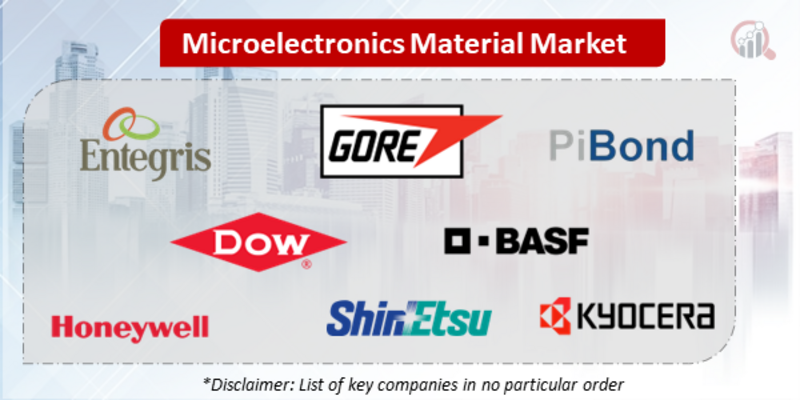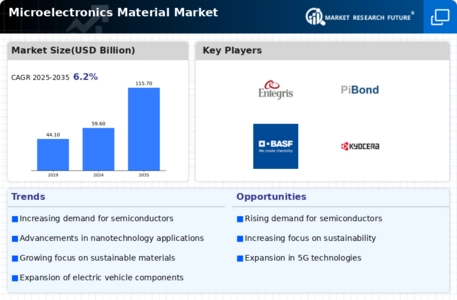Top Industry Leaders in the Microelectronics Material Market

Competitive Landscape of Microelectronics Material Market:
The microelectronics material market, a cornerstone of the global electronics industry, is a dynamic and fiercely competitive space. Fueled by the insatiable demand for miniaturization and performance enhancement in electronic devices. Navigating this landscape requires a keen understanding of the key players, their adopted strategies, and the factors shaping market share.
Key Players:
- Entegris
- L. Gore
- PiBond
- Dow Corning
- BASF
- Honeywell Electronic Materials
- Shin-Etsu MicroSi, Inc
- KYOCERA
- DuPont
- LORD Corp
Strategies Adopted by Key Players:
- Established Players: Companies like Dow Corning, Entegris, BASF, and Shin-Etsu Hical sit atop the market, leveraging their extensive portfolios, established supply chains, and strong brand recognition. Dow Corning, for instance, boasts a diverse range of silicon-based materials, while Entegris focuses on filtration and purification technologies crucial for chip fabrication.
- Regional Champions: Companies like SKC and Samsung SDI from South Korea and Taiwan's TSMC and UMC are carving a niche in specific material segments. SKC, for example, is a leader in high-purity silicon wafers, while TSMC's dominance in chip manufacturing translates to significant demand for its in-house materials.
- Mergers and Acquisitions (M&As): Consolidation is a defining trend, with established players acquiring smaller companies to expand their offerings or enter new segments. The recent acquisition of Versum Materials by Merck KGaA is a prime example, strengthening Merck's position in advanced packaging materials.
Factors Influencing Market Share:
- Technological Advancements: The relentless pursuit of smaller, faster, and more efficient chips drives the demand for novel materials with superior properties. Companies like DuPont and Honeywell are actively investing in R&D for materials like gallium nitride and graphene, offering enhanced performance for next-generation electronics.
- Geographical Shifts: The rise of electronics manufacturing hubs in Asia, particularly China and India, is creating new opportunities for regional players. Chinese companies like Jiangsu Hengsheng and Shanghai Xinyi are aggressively expanding their production capacities to cater to the domestic demand.
- Sustainability Concerns: Environmental regulations and growing consumer awareness are pushing for the adoption of sustainable materials and practices. Companies like W.L. Gore and 3M are developing lead-free solders and biodegradable packaging materials to cater to this growing demand.
New and Emerging Players:
- Start-ups: Driven by advancements in material science and nanotechnology, a wave of innovative start-ups is entering the market. Companies like Graphene Nanotechnologies and American Elements are developing disruptive materials with unique properties, potentially challenging established players.
- Vertical Integration: Leading chipmakers like Intel and Samsung are increasingly integrating backwards, developing their own material production capabilities. This vertical integration could reshape the competitive landscape by reducing reliance on external suppliers.
Industry Developments
Entegris:
- January 25, 2024: Entegris announces collaboration with imec on advanced packaging solutions for high-performance computing and AI applications.
- January 18, 2024: Entegris reports strong Q4 and full-year 2023 financial results, exceeding analyst expectations. Revenue grows 19% year-over-year, driven by demand for advanced semiconductor materials.
- December 12, 2023: Entegris unveils new PurityPlus™ filtration system for ultra-pure chemical delivery in advanced chipmaking.
Gore:
- January 20, 2024: L. Gore partners with Samsung Display on next-generation flexible OLED displays for foldable smartphones and other devices.
- December 5, 2023: L. Gore expands production capacity for MEBM® membranes used in semiconductor manufacturing at its facility in Newark, Delaware.
- November 15, 2023: L. Gore introduces GORE® PRIMECHOICE™ filtration membranes for improved particle and defect control in advanced chip production.
